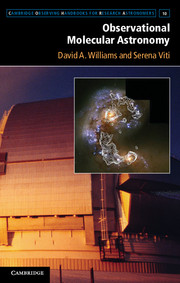Book contents
- Frontmatter
- Contents
- List of Illustrations
- List of Tables
- Preface
- 1 Introduction
- 2 Spectra and Excitation of Interstellar Molecules
- 3 Astrochemical Processes
- 4 Physical Processes in Different Astronomical Environments
- 5 Molecular Tracers in the Milky Way Galaxy
- 6 Molecular Tracers in External Galaxies
- 7 The Early Universe and the First Galaxies
- 8 Recipes for Molecular Submillimetre Astronomy
- 9 Chemical and Radiative Transfer Models
- 10 Observations: Which Molecule, Which Transition?
- Appendix: Acronyms
- Index
- References
10 - Observations: Which Molecule, Which Transition?
Published online by Cambridge University Press: 05 December 2013
- Frontmatter
- Contents
- List of Illustrations
- List of Tables
- Preface
- 1 Introduction
- 2 Spectra and Excitation of Interstellar Molecules
- 3 Astrochemical Processes
- 4 Physical Processes in Different Astronomical Environments
- 5 Molecular Tracers in the Milky Way Galaxy
- 6 Molecular Tracers in External Galaxies
- 7 The Early Universe and the First Galaxies
- 8 Recipes for Molecular Submillimetre Astronomy
- 9 Chemical and Radiative Transfer Models
- 10 Observations: Which Molecule, Which Transition?
- Appendix: Acronyms
- Index
- References
Summary
The preceding chapters in this book have demonstrated that to trace particular astronomical features in the Milky Way or in external galaxies by using molecular line emissions, the astronomer needs to choose lines corresponding to appropriate transitions. The transitions to use will, obviously, be those whose upper levels are readily populated in the gas that is to be observed. In many situations, the most important excitation mechanism to the upper level is collisional, and H2 is often the main collisional partner.
For example, we have seen that the CO(1–0) transition is appropriate for searching for and detecting cold neutral gas with a kinetic temperature of ∼10 K, where the number density of hydrogen molecules is ∼103 cm−3. However, observations of radiation emitted in this transition cannot reveal, say, the presence of either cold or warm gas at a density of, say, ∼105 cm−3, because collisional de-excitation of the upper level occurs before radiation in the (1–0) line can occur. Therefore, to observe gas at higher densities, observers must use more highly excited CO lines that have larger spontaneous radiation probabilities (assuming that these highly excited levels are sufficiently populated at the prevailing temperature). Alternatively, observers may use a line from some other molecular species that has more appropriate fundamental properties for the physical conditions in the gas to be observed. Of course, as we have seen in Chapters 8 and 9, complications introduced by high optical depths in the lines observed may also make it difficult to infer physical properties in the observed regions. The simple physics in the above arguments is encapsulated in the concept of critical density (see Section 2.3).
- Type
- Chapter
- Information
- Observational Molecular AstronomyExploring the Universe Using Molecular Line Emissions, pp. 165 - 168Publisher: Cambridge University PressPrint publication year: 2013

